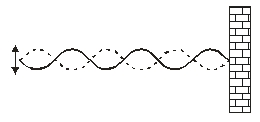Multiple Choice
A standing wave is created by oscillating a taut string at a frequency that corresponds to one of the resonant frequencies.The amplitude of the antinodes is very much larger than the amplitude of the oscillator.Does this violate the conservation of energy principle? Explain why. 
A) Yes,since E is proportional to amplitude squared.
B) Yes,since there is large kinetic energy of the string,and this is much bigger than the energy from the oscillator.
C) No,energy from waves does not obey the conservation of energy principle in the first place.
D) No,the energy at the antinodes builds up after the first few cycles,after which the dissipation due to friction equals the energy supplied by the oscillator.
E) Whether it obeys the conservation of energy principle depends on the tension in the string.
Correct Answer:

Verified
Correct Answer:
Verified
Q7: A guitar string of length 105 cm
Q8: A vibrating tuning fork of 850
Q9: If two identical waves with a
Q10: A string fixed at both ends is
Q11: The third harmonic of a tube closed
Q13: When an organ pipe,which is closed at
Q14: Two sound waves,one wave is given
Q15: A microphone is placed at the node
Q16: The standing waves in air in
Q17: On a standing-wave pattern,the distance between two